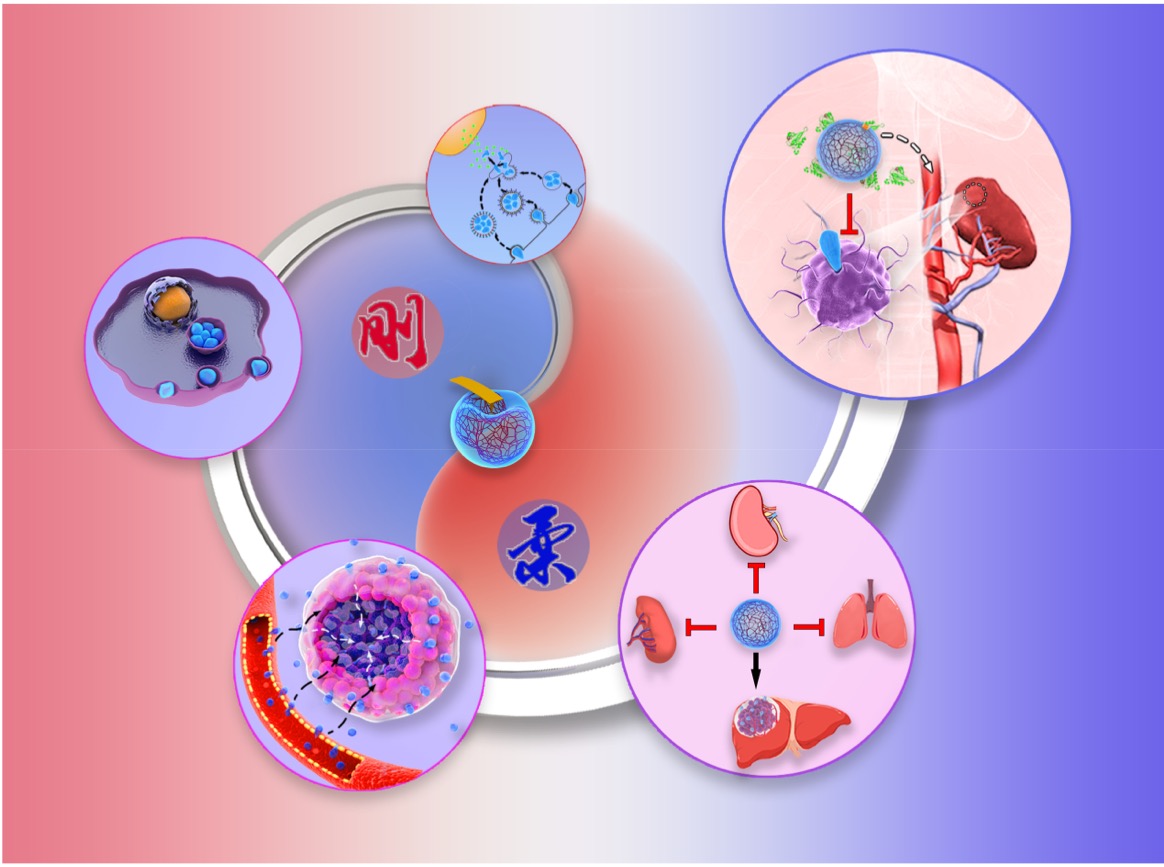(Correspondent Zheng Li) On March 26th, a tutorial review entitled “Influence of nanomedicine mechanical properties on tumor targeting delivery” was published on Chemical Society Reviews, which is contributed by Prof. Xiangliang Yang, Prof. Zifu Li and Prof. Lu Gan from College of Life Science & Technology and National Engineering Research Center for Nanomedicine, HUST. This review article was the first one to combine nanomedicine mechanical modulation with the Five Principles, deciphering the significant impact of nanomedicine mechanical properties on overcoming multiple pathophysiological barriers and tumor targeting delivery. This article was also elected as the Inside Front Cover.

In recent years, researchers found that nanocarriers could obviously improve pharmacokinetic and biodistribution of conventional chemotherapeutic drugs, further enhancing tumor targeting efficiency and decreasing toxic and side effects. Prof. Xiangliang Yang’s team put forward the Five Principles containing long circulation, tumor accumulation, deep penetration, cellular internalization and drug release, as a new strategy for tumor-targeted nanomedicine design. Based on the Five Principles, Prof. Xiangliang Yang’s team optimized the dynamics of nanomedicine in each stage in vivo by regulating physical and chemical properties of nanomedicine including size, ζ potential, hydrophilicity, surface charge, to name a few. All the nanomedicine designed by the Five Principles achieved enhanced antitumor efficiency and lower side effects, and the results were published on academic journals including Advanced Science (2018, 2020), Advanced Functional Materials (2020), Nature Communications (2019), Nano Letters (2018, 2019, 2019), ACS Nano (2019). On May 20th 2019, Prof. Xiangliang Yang and Prof. Lu Gan in cooperation with Prof. Bo Huang published the article entitled “The softness of tumour-cell-derived microparticles regulates their drug-delivery efficiency” on Nature Biomedical Engineering, the top journal in biomedical engineering field. This article suggested that the mechanical properties of tumour-cell-derived microparticles, such as softness and deformability, could obviously affect the pharmacodynamics and pharmacokinetics of nanomedicine, providing a new strategy for nanomedicine design. This achievement was rated as “Top Ten Academic Progresses of Huazhong University of Science and Technology in 2019” and was highly recognized by scholars in related communities.
Based on this important progress, invited by top chemical journal Chemical Society Reviews, Prof. Zifu Li and Prof. Xiangliang Yang summarized and published the tutorial review about the effects of nanomedicine mechanical properties on each stage of Five Principles. First of all, this review concisely introduced the great attention caught by mechanical properties in nanomedicine field. Subsequently, the review gave a comparison among several commonly used mechanical testing techniques including their advantages and limitations. Meanwhile, nine nanocarriers containing hydrogel particle, polymer micelle, cylindrical polymer brush, silica nanocapsule, layer-by-layer self-assembled capsule, discoidal particle, nanovesicle, hybrid particle, tumor cell derived microparticle, and the regulation of mechanical properties, were clarified, providing a valuable reference for mechanical design and characterization of nanocarriers. Afterwards, the effects of mechanical properties of nanomedicine on long circulation, tumor accumulation, deep penetration, cellular internalization and drug release, which are stages of Five Principles, were introduced and analyzed in detail. In the first stage, soft nanomedicine preferred to avoid macrophages uptake and clearance by the mononuclear phagocyte system (MPS) or the reticuloendothelial system (RES), achieving long circulation and higher chance of reaching tumor site. In the second stage, compared with stiff nanomedicine, soft nanomedicine showed higher tumor accumulation and lower liver accumulation. In the third stage, soft nanomedicine could squeeze through the gap between tumor cells and achieve deep penetration, relying on the better deformability. In the fourth stage, several studies showed soft nanomedicine were more likely internalized by cells compared with the stiff one. However, internalization was very complicated and it was affected by many factors such as internalization pathway and surface properties of nanomedicine. Further research was required. In the fifth stage, soft nanogels showed higher drug release efficiency because of lower network density, while other types of nanomedicine showed no obvious mechanical-properties-dependent drug release behavior. Finally, the review summarized the effects of nanomedicine mechanical properties on drug delivery efficiency and antitumor efficacy. Besides, six issues worthy of attention in the future were discussed and some feasible solutions were proposed.
Ph.D. candidates Zheng Li, Chen Xiao and postdoc Tuying Yong from College of Life Science & Technology are co-first authors of this review paper. Prof. Xiangliang Yang, Prof. Zifu Li and Prof. Lu Gan from College of Life Science & Technology are co- corresponding authors. This review paper is supported by grants from the National Key Research and Development Program of China, National Science Foundation of China and the Program for HUST Academic Frontier Youth Team (Mechano-nanooncology).
The paper link:https://doi.org/10.1039/C9CS00575G